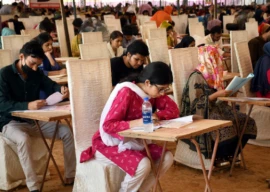
“The continuous strengthening of the rupee against the dollar in the third quarter (Jan-Mar) of fiscal year 2014 is going to reduce the cost of imports of the auto industry in coming months,” Global Research analyst Imran Ahmed Patel told The Express Tribune.
Since January 1, 2014, the rupee has appreciated 5.2% against the dollar. The jump in the rupee’s value in the last two weeks was a staggering 4.9%.
The continuous appreciation of the rupee is going to improve gross profit margins of auto companies, which are likely to be visible from the third quarter (Jul-Sep) of calendar year 2014 onwards (assuming 4-5 month lagging impact), said Patel, adding that we might see a cut in car prices but only if current exchange rates sustain at the current levels.
When asked about the positive effects of the reduction of 2% GST, he said that according to his conversation with the industry officials, auto parts’ makers were not paying this additional GST to the government hence it would not influence the market dynamics as such.
“The government’s move to take back additional 2% GST is a positive signal to the industry,” said Patel, “But what is more important for the government is to give a growth-oriented auto policy to the local industry in the upcoming budget.”
The government’s recent offer to give incentives in the upcoming budget has buoyed the sentiments of the industry that has been unsure about the government intentions on the upcoming auto policy. With these government moves, industry officials and analysts anticipate that the government may restrict its policy on the import of used cars to support the local industry.
Analysts say that the local industry seems optimistic, which is why all the three leading companies are looking to launch new cars in the coming months. Moreover, looking at the jump of 8% in car sales in the first 8-months (Jul-Feb) of FY14, industry expects to end this year on a better note compared to the previous year.
“With an 8% increase in car sales in the last 8-months of current fiscal year, the rupee appreciation against the dollar is just the icing on the cake,” BMA Capital analyst Zoya Ahmed said.
Exchange rate volatility in the first half (Jul-Dec) of FY14 remained a key concern for domestic auto assemblers as they are largely dependent on imported components from Japan, Thailand and others countries. Published in The Express Tribune, March 12th, 2014.
Like Business on Facebook, follow @TribuneBiz on Twitter to stay informed and join in the conversation.
COMMENTS (5)
Comments are moderated and generally will be posted if they are on-topic and not abusive.
For more information, please see our Comments FAQ

1726117332-0/Megan-Thee-Stallion-(1)1726117332-0-165x106.webp)





















@Parvez - Morals could have helped if the government starts thinking that the base cars need to be kept affordable versus forcing people to buy used /reconditioned / odd looking discarded cars from Japan /Korea etc.
As for the supply -demand argument , since we know the demand would remain high in short term that would encourage local automakers (assemblers) to price up or maintain price despite any savings / relief from government :(
@faraz: Agree. Price is determined by market forces of supply and demand......morals have no place in this.
I doubt seeing price cuts in Pak's auto industry
Waiting for the time when benefit of strengthened rupee will be passed on to the end user
Great. So price increase as soon as $ goes up and price cut IF rupee sustains current value. It's a win-win game for the automakers who are selling poor quality stuff at significantly higher prices compared to rest of the world!